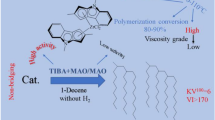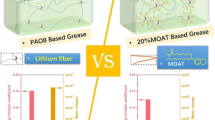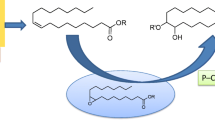Abstract
Fatty monoester lubricant base oils as high as 96.7 mol% were prepared by reacting methyl oleate with long-chain alcohols viz., 2-ethyl-1-hexanol (C8−OH), 1-decanol (C10OH) and 1-dodecanol (C12OH) in the presence of a solid Fe-Zn double-metal cyanide (DMC) complex catalyst. Unlike many other acid catalysts, DMC doesn’t produce undesired ether side products. The catalyst was reusable in four recycling experiments with little loss in catalytic activity and ester yield. The long-chain esters prepared in the study have the desired physical properties for their application as lubricant base oils.

Biolubricant base oils were synthesized by transesterification of methyl oleate (a component of biodiesel) with long-chain monohydric alcohols in presence of a reusable Fe-Zn double-metal cyanide catalyst. Fatty monoester yield as high as 96.7 mol% was obtained.
Similar content being viewed by others
Explore related subjects
Discover the latest articles, news and stories from top researchers in related subjects.Avoid common mistakes on your manuscript.
1 Introduction
High performance, long product life and better ecological compatibility are the characteristic features that make fatty monoesters important as high quality biodegradable lubricant base oils.[1,2] Unlike other synthetic oils ca. poly alpha-olefins (PAO) and poly alkylene glycols (PAG), the ester oils are miscible with a large number of additives to formulate effective biodegradable lubricants. Currently, more than 10,000 lubricant formulations are needed to meet the world demand of 12 billion gallons per year.[3–5] Through a proper choice of fatty acid and long-chain alcohol, a wide variety of lubricants with custom design properties can be synthesized. Biodegradable lubricants reduce environmental pollution which the conventional mineral oil-based lubricants cause after their usage.
Note: about 53% of mineral oil lubricants are collected as waste endangering the planet.[6]
Monoesters are categorized as ‘non-water pollutant’ lubes which reduce the expenses of oil spillage or disposal. It is realized that more than 90% of all the current lubricants could be formulated to be rapidly biodegradable.[6] The ester oils are normally for high-end usage due to their higher price. Biolubricants are priced twice as high as conventional petroleum lubricants. As a consequence, only a few percentage of the market for slippery fluids is commanded by bio-based lubricants.[3,7] They are produced by esterification of a fatty acid or transesterification of vegetable oil with a long-chain alcohol in presence of a homogeneous acid/base catalyst[8–10] or by using an ion-exchange resin.[11,12] Their synthesis from the reaction of fatty acid methyl esters (FAME-biodiesel) and long-chain alcohol is attractive, as a part of biodiesel pool, can be converted to more valuable lube product. This diversion possibly makes biodiesel production economical even in the absence of incentives from the government.
Cost effective production of synthetic esters is of utmost importance for their wider use. The homogeneous mineral acid or base catalysts currently used are non-reusable. Additional process steps are needed for catalyst neutralization and separation. Significant amount of salt and hard water is generated as waste by-product. Ion exchange resins have limited thermal stability confining their application to reactions with short chain alcohols only. Use of solid catalysts in place of homogeneous catalysts make the process attractive and cost-effective. Solid catalysts can be recyclable and processes involving them can be green and zero-waste generating. Silica-sulphuric acid, Amberlyst-15, immobilized lipase (NovozymⓇ435), sulfated zirconia, calcium methoxide, titanosilicates and zirconium phenyl phosphonate phosphite are a few solid catalysts reported for biolubricants’ preparation.[13–18] Earlier, we reported the application of Fe-Zn double-metal cyanide (DMC) complex as an efficient catalyst for producing biolubrciants by transesterification of vegetable oils with linear chain monohydric C8 alcohol[19] and esterification of oleic acid with polyhydric alcohols.[20] We now extend the study reporting their use for transesterfication of methyl oleate (a component of biodiesel) with 2-ethyl-1-hexanol (C8OH), 1-decanol (C10OH) and 1-dodecanol (C12OH) producing the corresponding long-chain alcohol monoesters. DMC complexes are hydrophobic and Lewis acid catalysts.[19,20] The lubricant properties of the produced monoesters are reported.
2 Experimental
2.1 Catalyst preparation
DMC was prepared as reported by us earlier[19] using K4Fe(CN)6·3H2O as a source of Fe, ZnCl2 as a source of Zn, tert.-butanol as complexing agent and PEG-4000 as co-complexing agent. Prior to use in reactions, the DMC catalyst was activated at 180∘C for 2 h.
2.2 Characterization techniques
X-ray powder diffraction (XRD) patterns of fresh and spent DMC catalysts were recorded on a Phillips X’pert Pro diffractometer equipped with a Ni-filtered Cu-K α radiation (λ= 0.15418 nm, 40 kV and 30 mA) and a proportional counter detector. The diffraction patterns were recorded in the 2 𝜃 range of 10–800 with a scan rate of 4∘/min and with a step size of 0.02∘. Fourier transform infrared (FTIR) spectra of the samples as KBr pellets (1 wt %) were measured in the wavenumber range of 400–4000 cm−1 with a spectral resolution of 4 cm−1 on a Shimadzu 8300 spectrophotometer. All the other characterization studies were done as reported elsewhere.[19,20] Physical properties of fatty acid monoesters were determined at Chem-Tech Laboratories Pvt. Ltd., Pune, India (Supplementary Information).
2.3 Reaction procedure
Methyl oleate (MO, Sigma-Aldrich Co., technical grade 70%; balance 30% being methyl palmitate and stearate) was transesterified with C8–C12 alcohols [2-ethyl-1-hexanol (Loba Chemie, 99%), 1-decanol and 1-dodecanol (SD Fine Chem.]. In a typical reaction, 6.76 mmol of MO and three equivalent excess of alcohol and 0.06 g of DMC catalyst (3 wt% of MO) were taken in a glass, round-bottom flask placed in a temperature-controlled oil bath and connected with a water-cooled condenser. Temperature was raised to 180∘C and the reaction was conducted for 8h at atmospheric pressure under a flow of nitrogen. Nitrogen drives out the by-product methanol formed in the reaction and pushes the equilibrium towards the product. Then, the temperature of the reaction mixture was brought down to room temperature (25∘C) and the catalyst was separated by centrifugation (RCF = 7000 g for 5 min using a Remi Laboratory Instrument, Model No. R-24)/filtraton. Excess, unreacted alcohol in the product mixture was removed by steam-distillation. The product monoester was analyzed by a Perkin-Elmer (Series 200) high performance liquid chromatography fitted with an ELSD detector (Gilson) and reverse-phase Brownlee column (C-18, Spheri-5, 250 × 4.6 mm). For kinetics studies, reactions were conducted at five different temperatures (433, 443, 453, 463 and 473 K) for a period of 4h. Rate constants were determined from the concentration verses time plots using a pseudo-first order rate equation. Arrhenius equation enabled determination of thermodynamic parameters (activation energy and Gibbs free energy). The yield of oleic fatty monoester was confirmed also by1H NMR (Bruker Avance 200 MHz) and gas chromatography (GC, Varian CP 3800; column - Varian CP 9079, 15 m long × 0.32 mm ID × 0.1 um film thickness) techniques. It should be noted that methyl palmitate and stearates present in MO as impurity (30%) have also been converted to the corresponding lube esters with equal efficiency as that of methyl oleate.
3 Results and discussion
3.1 Catalyst characterization
A detailed characterization of Fe-Zn DMC catalyst was reported by us earlier.[19,20] Table 1 lists some characteristic parameters of the catalyst used in this study. DMC (molecular formula: K4Zn4[Fe(CN)6]3.6H2O.2(tert.- BuOH) and molecular structure as shown in scheme 1) depicted XRD pattern (figure 1a) which could be indexed to a cubic lattice with a unit cell parameter of 0.904 nm. FTIR spectrum of DMC (figure 1b) showed a characteristic band at 2096 cm−1 due to bridged cyanide group and other bands at 2925, 1260–1450 and 1095 cm−1 corresponding to C–H and C–O stretching vibrations of the coordinated tert.-butanol. Nitrogen-physisorption and high resolution transmission electron microscopy (HRTEM) studies revealed that DMC is mostly microporous but has some mesoporosity of less ordered nature in its structure.[21] Diffuse reflectance Fourier transform infrared (DRIFT) spectra of adsorbed pyridine and temperature-programmed desorption of ammonia (NH3-TPD) pointed out that it is Lewis acidic.[19,22] Tetrahedrally coordinated Zn2+ are the sites of Lewis acidity which were active in transesterification reactions.[23] Water adsorption studies revealed that this catalyst is hydrophobic like silicalite-1.[19] Hydrophobicity and Lewis acidity are the two unique characteristic features that differentiate DMC from several other solid acid catalysts.
3.2 Catalytic activity
Transesterification of methyl oleate (MO) with long-chain monohydric alcohols (2-ethyl-1-hexanol, 1-decanol and 1-dodecanol) yields fatty acid monoesters that find application not only in synthetic lubricants but in paint additives, plasticizers, pharmaceuticals and cosmetics (scheme 1). Methanol is a by-product. Formation of ethers via condensation of long-chain alcohols or methanol was not detected at our experimental conditions over DMC catalyst (HPLC, GC and 1H NMR). Control experiments at 180∘C for 8 h with 2-ethyl-1-hexanol/MO molar ratio = 3, revealed that this reaction occurs even in the absence of a catalyst. But the yield of 2-ethylhexyl oleate was 37 mol% only (figure 2a). In presence of DMC catalyst, the yield was higher. It increased with increasing amount of the catalyst, reaching a maximum of 70 mol% at a catalyst loading of 3 wt% of MO and became stable thereafter (reaction conditions: methyl oleate (MO) = 2 g, 2-ethyl-1-hexanol = 2.64 g, temperature = 180∘C and reaction time = 8 h). External mass transfer is the possible cause for this behavior at a catalyst loading above 3 wt%. 2-Ethyl-1-hexanol/MO molar ratio had also a marked effect on the product yield (figure 2b). The yield of 2-ethylhexyl oleate increased, reached a maximum of 70 mol% at a 2-ethyl-1-hexanol/MO molar ratio of 3 and decreased thereafter (reaction conditions: 180∘C, reaction time = 8h and catalyst = 3 wt% of MO). Transesterification is an equilibrium reaction. Higher amount of 2-ethyl-1-hexanol drives the equilibrium toward right, forming fatty monoester lubricant. At much higher concentrations of 2-ethyl-1-hexanol (molar ratio of 2-ethyl-1-hexanol/MO ≥ 5), accessibility of MO to the active sites was low and hence, lower yields of 2-ethylhexyl oleate were obtained. Under similar experimental conditions, the product yield increased with increasing reaction time and attained equilibrium at 8 h. Also with increasing temperature, the yield of 2-ethylhexyl oleate increased. At 180∘C and in 4h, monoester yield as high as 96.7 mol% was obtained (figure 3a). At high temperature, most of the known acid catalysts form ethers. The unique feature of DMC is that even at 180∘C, formation of such undesired ether products was not detected. The selectivity for the monoester and methanol were 100%. DMC was reused in four recycling experiments. At the end of each run, the catalyst was separated from the reaction mixture; it was washed with methanol, dried at 100°C for 12h and used in another recycle. The yield of 2-ethylhexyl oleate was nearly the same in each recycle. XRD and FTIR spectra of the fresh and spent catalyst (at the end of 4th recycle) were almost the same (figure 1) confirming the structural integrity of DMC in transesterification runs. No leaching of metal ions was detected as revealed by atomic absorption spectroscopy (AAS). Conversion verses time plots at five different temperatures enabled rate constant and energy of activation (E a from the Arrhenius plot). The E a value was determined to be 75.9 kJ/mol. Using Eyring equation enthalpy of activation (ΔH #) and entropy of activation (ΔS #) were determined to be 72.3 kJ/mol and 283.3 J/mol, respectively. As this reaction proceeds to some extent even in the absence of a catalyst, the activation energy has contributions from both thermal and catalytic reactions.
Effects of (a) catalyst amount and (b) 2-ethyl-1-hexanol/MO molar ratio on the yield of 2-ethylhexyl oleate. Reaction conditions: For (a): methyl oleate (MO) = 2 g, 2-ethyl-1-hexanol = 2.64 g, MO : 2-ethyl-1-hexanol (molar ratio) = 1:3, temperature = 180∘C, reaction time = 8 h, pressure = 1 atm, under a positive flow of nitrogen. For (b): MO = 2 g, DMC = 3 wt% of MO, temperature = 180∘C, reaction time = 8 h, pressure = 1 atm, under a positive flow of nitrogen.
Effect of (a) reaction temperature and time and (b) type of long-chain alcohol on the yield of fatty monoester. Reaction conditions: For (a): methyl oleate (MO) = 2 g, 2-ethyl-1-hexanol = 2.64 g, MO: 2-ethyl-1-hexanol (molar ratio) = 1 : 3, DMC = 3 wt% of MO, pressure = 1 atm, under positive flow of nitrogen. For (b): MO = 2 g, MO: long-chain alcohol (molar ratio) = 1:3, DMC = 3 wt% of MO, reaction temperature = 180∘C, reaction time = 8 h, pressure = 1 atm, under a positive flow of nitrogen.
DMC is effective for transesterification of MO with different long-chain alcohols (figure 3b). A marginal decrease in equilibrium conversion of MO from 70 to 62 mol% was observed when 1-dodecanol instead of 2-ethyl-1-hexanol was used. The monoester product after removal of methanol and unreacted long-chain alcohol was pale yellow in color. Its physical properties (table 2) match well with those of hydraulic oil lubricants confirming that these long-chain alcohol fatty esters are suitable lubricant base oil. Kinematic viscosity of long-chain alcohol oleates were higher than that of the starting ester (MO). As expected, 2-ethylhexyl oleate has pour point lower than the other esters and MO.
A tentative mechanism for this reaction over Lewis acidic Zn2+ active sites in DMC catalyst is shown in figure 4. Activation of MO at Zn2+ site; formation of carbocation; nucleophilic attack by the long-chain alcohol (2-ethyl-1-hexanol, for example) on the carbo cation, followed by removal of methanol and long-chain alcohol oleate ester formation are the steps involved in the reaction.
4 Conclusions
Catalytic activity of DMC for forming fatty monoester lubricants through transesterification of methyl oleate (FAME-biodiesel) with long-chain alcohols (2-ethyl-1-hexanol, 1-decanol and 1-dodecanol) was investigated. 2-Ethylhexyl oleate yield as high as 96.7 mol% was achieved at 180∘C in 4 h. DMC was reusable in at least four recycling experiments with little loss in catalytic activity. The product long-chain alcohol ester had the desired physical properties required for lubricant applications. Fatty monoesters of long-chain alcohols were the selective products over DMC. Formation of undesired ether products were not detected even at 200∘C. Our earlier studies and this work together reveal that Fe-Zn DMC is an efficient catalyst for converting fatty compounds (vegetable oils, fatty acids and/or fatty acid methyl esters) into lubricant base oils by esterificationi/transesterification reactions.
References
Rudnick L R 2006 Synthetics, mineral oils and bio-based lubricants: chemistry and technology (Boca Raton, USA: Taylor & Francis, CRC Press)
Honary L A T and Richter E 2011 Biobased lubricants and greases: Technology and products (West Sussex, UK: John-Wiley & Sons Ltd.)
Bomgardner M M 2013 C&EN October 28 19
Mang T 2007 In Lubricants and lubrication (eds.) T Mang and W Dresel (Weinheim, Germany: Wiley-VCH Verlag GmbH & Co. KgaA)
Wagner H, Luther R, and Mang T 2001 Appl. Catal. A: Gen. 221 429
Höfer R and Bigorra J 2007 Green Chem. 9 203
Resul M F M G, Ghazi T I M, and Idris A 2012 Ind. Crops Product. 38 87
Padmaja K V, Rao B V S K, Reddy R K, Bhaskar P S, Singh A K, and Prasad R B N 2012 Ind. Crops Product. 35 237
US Patent No. 8,101,560 B2
Nagendramma P 2011 Lubrication Sci. 23 355
Madankar C S, Dalai A K, and Naik S N 2013 Ind. Crops Product. 44 139
Åkerman C O, Gaber Y, Ghani N A, Lämsä M, and Hatti-Kaul R 2011 J. Mol. Catal. B: Enz. 72 263
Oh J, Yang S, Kim C, Choi I, Kim J H, and Lee H 2013 Appl. Catal. A: Gen. 455 164
Masood H, Yunus R, Choong T S Y, Rashid U, and Taufiq Yap Y H 2012 Appl. Catal A: Gen. 425–426 184
Santacesaria E, Martinez Vicente G, Di Serio M, and Tesser R 2012 Catal. Today 195 2
Kotwal M, Kumar A, and Srinivas D 2013 J. Mol. Catal: Chem. 377 65
Varhadi P, Kotwal M and Srinivas D 2013 Appl. Catal. A: Gen 462 129
Sreeprasanth P S, Srivastava R, Srinivas D, and Ratnasamy P 2006 Appl. Catal. A: Gen. 314 148
Kotwal M, Deshpande S S, and Srinivas D 2011 Catal. Commun. 12 1302
Sebastian J and Srinivas D 2011 Chem. Commun. 47 10449
Satyarthi J K and Srinivas D 2010 Energy Fuel 24 2154
Srivastava R, Srinivas D, and Ratnasamy P 2006 J. Catal. 241 34
Acknowledgements
M K acknowledges the Council of Scientific and Industrial Research (CSIR), New Delhi for the award of Senior Research Fellowship. This work forms a part of the Network Project ‘Catalysts for Sustainable Energy (ECat, CSC 0117)’ sponsored by CSIR.
Author information
Authors and Affiliations
Corresponding author
Additional information
Supplementary Information
Details on analytical studies and properties of lubricant base oil are available as supporting information in the Journal of Chemical Sciences website (www.ias.ac.in/chemsci).
Electronic supplementary material
Below is the link to the electronic supplementary material.
Rights and permissions
About this article
Cite this article
RAUT, R.K., SHAIKH, M. & DARBHA, S. Synthesis of fatty monoester lubricant base oil catalyzed by Fe-Zn double-metal cyanide complex. J Chem Sci 126, 997–1003 (2014). https://doi.org/10.1007/s12039-014-0669-x
Received:
Revised:
Accepted:
Published:
Issue Date:
DOI: https://doi.org/10.1007/s12039-014-0669-x









